FRED STANLEY SALMONI
Lance Corporal, 15th Battalion, Australian Infantry, A.I.F.( Service Number 791)
Fred Stanley Salmoni was born on 24 Dec 1892 in Roath, Cardiff to William Salmoni, a painter and decorator, originally from Wells, Somerset, and Mary Salmoni née Hudgins originally from Pentyrch, Glamorgan. The Salmoni family lived at 8 Elm Street, Roath and Fred attended Stacey Road school and was a member of the 14th Company Cardiff Boy’s Brigade. After leaving school he became a fitters helper in a colliery above ground. He emigrated to Australia in 1912. Fred Salmoni joined his aunt and uncle in Childers in Queensland and took up a lease to farm 260 acres of timberland in the Good Night Scrub on the Burnell River in 1914. On the outbreak of war he enlisted in Brisbane in the Australian Contingent, travelled initially to Egypt then Turkey but was killed in action at Gallipoli on 28 April 1915 aged 21. On the morning of the 27th his platoon commander, Lieut. T. Robertson, with a party of thirty picked men (including Salmoni) went forward to occupy an outpost position in advance of the main line of defence. Early the following morning the enemy massed in large numbers opposite their position and demanded their surrender; this was refused, but as they were greatly outnumbered they had to retire, and only a few of the party succeeded in reaching the main line. Although killed on 28 April, his body was not found until the 24 May. He was buried in Shrapnel Valley, about one mile north-east of Gaba Tepe, Turkey. The exact whereabouts of the grave was subsequently lost. Following his death there was a successful claim for part of his war pension by Ethel Rose Baker of 82 Elm Street, Cardiff on behalf of a son Kenneth John Baker, born illegitimately in July 1912. His decision to emigrate may have been motivated by the birth of his illegitimate son. It turns out that in adulthood, Kenneth Baker also worked as a fitter. Commonwealth War Graves Commission record. Australia holds a Last Post Ceremony at the Australian War Memorial in Canberra each day. At each ceremony the story behind one of the names on the Roll of Honour is told. On 22 March 2017 the story of Lance Corporal Fred Salmoni was told. A video of the ceremony is available and his story starts at 5min 45sec into the recording. He is also remembered on the Gin Gin Cenotaph, and in the Isis Shire Council Chambers and Memorial Hall, and on a virtual Queensland Roll of Honour Australia. Back home he doesn’t appear to be remembered on any memorials though was mentioned in an edition of the Roath Roamer magazine of the Roath Road Wesleyan Methodist Church.
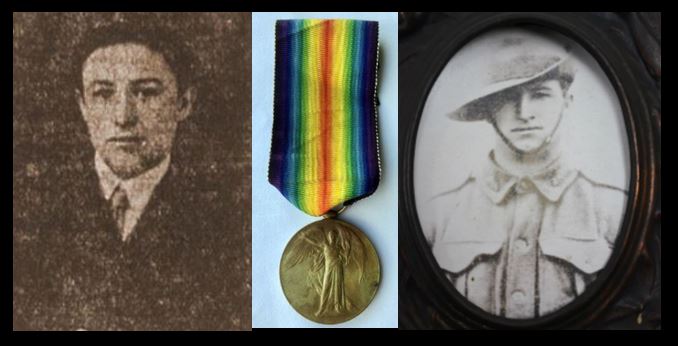
GILBERT GEORGE SCRIVENS
Lance Corporal, No 4 Company, Household Battalion (Service Number: 1194)
Gilbert George Scrivens was born on 25 Dec 1897 in Badgeworth, Gloucestershire to Charles John George Scrivens, a fruiterer, originally from Elmstone Hardwicke, Gloucestershire, and Caroline Annie Scrivens nee Dimery originally from Cinderford, Gloucestershire. In 1901 the Scrivens family were living in Gloucestershire but moved to Cardiff shortly afterwards. In 1905, when they were living at 39 Salisbury Road, Gilbert was admitted to Albany Road school. His record shows that he had already attended Court Road School in Grangetown previously. In 1911 the Scivens family were living at 119 Clifton Street. By 1916 when Gilbert enlisted in the 1st Life Guards the Scivens family had moved to High Street, Merthyr Tydfil, where he had been working as a fruiterer, presumably in his father’s business. He later transferred to the Household Battalion of the Household Cavalry and attained the rank of Lance Corporal. He was killed in action at the Battle of Arras on 12 Apr 1917 aged 19. He is buried at Brown’s Copse Cemetery, Roeux, France (grave I.H.25). He is also remembered on the headstone of his mother Caroline and brother Sidney Scrivens at Holy Trinity church, Badgeworth, Gloucestershire. In Cardiff he was remembered on a war memorial plaque from a church of unknown location and a Roll of Honour. Commonwealth War Grave Commission record.
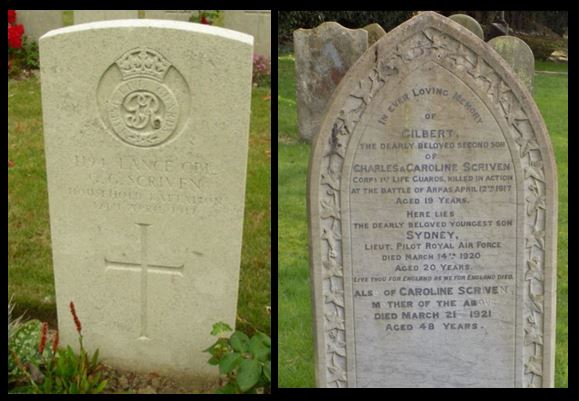
SIDNEY ALBERT SCRIVENS
Second Lieutenant, Royal Air Force (Service Number 767161)
Sidney Albert Scrivens was born on 25 May 1899 in Badgeworth, Gloucestershire to Charles John George Scrivens, a fruiterer, originally from Elmstone Hardwicke, Gloucestershire, and Caroline Annie Scrivens nee Dimery originally from Cinderford, Gloucestershire. In 1901 the Scrivens family were living in Gloucestershire but moved to Cardiff shortly afterwards. In 1905, when they were living at 39 Salisbury Road, Sidney was admitted to Albany Road school. His record shows that he had already attended Court Road School in Grangetown previously. In 1911 the Scrivens family were living at 119 Clifton Street. By 1917 when Sidney enlisted in the 28th Battalion of the London Regiment the Scrivens family had moved to High Street, Merthyr Tydfil. He later transferred to the Royal Air Force in 1918 and attained the rank of Second Lieutenant. It seems he left the RAF in 1919. He died on 14 Mar 1920 aged 20. It is not clear how he died but the fact that he has a Commonwealth War Graves Commission record indicates that it was related to his war service. He is buried at Holy Trinity church, Badgeworth, Gloucestershire together with his mother who died a year later. His brother Gilbert who died at the Battle of Arras is also remembered on the headstone (see above). Commonwealth War Grave Commission record.
WILLIAM HENRY SEAGER
Second Lieutenant, 10th Battalion, South Wales Borderers

William ‘Willie’ Henry Seager was born in Cardiff on 28 Jan 1893 to William Henry Seager, originally from Cardiff and Margaret Annie Seager née Elliot originally from South Shields, County Durham. His father was a prominent ship-owner and ship’s chandler who was knighted in 1918 who was also the Liberal MP for Cardiff East between 1918 and 1928. In 1901 the Seager family lived at Pitman Street, Riverside but moved to 203 Newport Road shortly afterwards. Willie spent three years at Cardiff High School from 15 Jan 1903 until 1906. He then completed his education at Queen’s College, Taunton. He was an active member of the Roath Road Wesleyan Chapel and was closely involved with the Sunday School there. He was first employed with the Cardiff ship-owners and coal exporters Lambert Brothers Ltd. After gaining experience in the shipping trade with them, when he was 21, he joined his father’s firm W.H. Seager and Co on 14 Feb 1914 and was later made a director while in the Army. At the outbreak of war, he attempted to enlist but was rejected twice as medically unfit. However, he persisted and was finally accepted at the third attempt. His address then was given as 60 Newport Rd. By Dec 1914.he was serving as a private in No. 2 Company 21st Battalion Royal Fusiliers (4th Public Schools) which was then in training at Ashstead, Surrey. That month, however, he applied for a commission in the Welsh Army Corps and he was eventually commissioned second lieutenant on 4 May 1915, joining the 10th Battalion (1st Gwent) South Wales Borderers who were at Colwyn Bay. After further training near Winchester at Hursley Park and Hazely Down, the 10th South Wales Borderers went out to France with the rest of the 38th (Welsh) Division in Dec 1915, landing at Le Havre on the 4th. The Welsh Division spent the next few weeks training and by mid-January they were deemed ready to take over part of the front line themselves near Neuve Chapelle. At this time, it was a fairly quiet area, apart from snipers and shellfire. Very shortly afterwards, however, while Willie was supervising the repair of a trench which had been damaged by shellfire, he was hit in the chest by sniper-fire. After only a few weeks in the front line, Second Lieutenant William Seager was killed in action at Neuve Chapelle on 7 Feb 1916. He was 23. His company commander wrote: “By his unbounded generosity, joviality and capability he has endeared himself to every officer and man of the company. The men have lost a brilliant leader, and I – well, I have lost a brother who was my right-hand man.” He was buried by his comrades nearby at what is now St. Vaast Post Military Cemetery, Richebourg L’Avoué, six miles north-east of Béthune (grave II. O. 11). Commonwealth War Graves Commission record. He is commemorated on the Cardiff High School memorial plaque, Queen’s College Taunton memorial, Roath Road Wesleyan Church war memorial and Cardiff Coal Exchange war memorial. Within months of his death, his parents donated funds in his name for a new operating theatre at the Cardiff Royal Infirmary and a special memorial plaque was placed there. A similar plaque existed in Whitchurch Hospital. They also endowed a bed in his memory at the Royal Hamadryad Seamen’s Hospital in the Docks. In addition, his parents dedicated two stained glass windows to his memory: one at Conway Road Methodist Church in Canton; and the other at Roath Road Wesleyan Chapel, which was located at the junction of City Road and Newport Road but destroyed by bombing during the Blitz. In 1939, the Willie Seager Memorial Trust was established to build and manage ten homes in Newport Road for retired seamen and their wives. In 1995, the Trustees replaced these with ten new homes in Westville Place, Penylan. Exactly a hundred years to the day after his death, in a special centenary service, the Willie Seager Trust dedicated a memorial stone at St. Edward’s Church in Roath to his memory, now outside the houses in Westville Place. Cardiff schoolchildren also used to compete annually for the Seager Baseball Cup. Finally, he is remembered on the Seager family grave at Cathays cemetery.


LAUNCELOT BRIDGES SHIPTON
Private, 14th Battalion, Welsh Regiment (Service Number: 57296)

Launcelot Bridges Shipton was born in Marianna, Florida, USA on 4 Oct 1889 to Richard Frederick Martin Shipton, an accountant, originally from Clifton, Gloucestershire and Julie Henrietta Shipton nee Hill, originally from Bristol. The Shipton family returned from Florida and were lived in Cardiff in 1901. He was educated at Monkton House school. In 1911 they lived at 37 Deri Road, Pen-y-lan and Launcelot worked as an accountant with the Western Mail. He joined the 7th (cyclist) battalion of the Welsh Regiment in Dec 1915 before transferring to the 14th battalion where he was employed as a runner. He served in France and Flanders from Jul 1916. He died at No 54 Casualty Clearing Station on 18 Oct 1917 aged 28 of wounds received in action the previous day. He is buried at the Estaires Communal Cemetery Extension (grave V. B. 15). He is remembered on the Western Mail Roll of Honour. Commonwealth War Graves Commission record. (As an aside, his niece, Dr Margaret Shotton, Consultant Obstetrician, delivered Britain’s first sextuplets at Birmingham’s Maternity hospital in 1968.)
THOMAS STANLEY SILBY
Lieutenant, 10th Battalion, South Wales Borderers
Thomas Stanley Silby was born in Cardiff on 11 Jan 1895 to John William Silby, a coal trimmer originally from Trowbridge, Wiltshire and Elizabeth Ann Silby nee Jenkins originally from St Mellons, Monmouthshire. In 1901 the Silby family were living at 8 Hinton Street, Splott. He attended Moorland Road Elementary School before going on to Howard Gardens School in 1905. He left in 1908 and began work as a clerk in the City Treasurer’s Department. In 1911 Thomas and the Silby family had moved to 19 Cressy Road. In WWI he initially enlisted in the Welsh Regiment in Sep 1915 as Private and was then Corporal in the Cheshire Regiment before becoming a Lieutenant with the Welsh Borderers. He was awarded the Military Cross in 1917 for his actions on 19 Sep 1917 at L’Epinette: ‘For conspicuous gallantry and devotion to duty during a hostile raid on an advanced post. Hearing that the commander of his post had been killed, he went forward from the support line under a heavy barrage and took command. He rallied the men at a critical moment and drove off the enemy. He showed great courage, coolness and initiative.’ He married Ethelinda ‘Linda’ Harriet Hudson, who lived at 138 Richmond Road, in St James the Great church, Cardiff on 14 Aug 1918. He then returned to the Western Front and was sadly killed in action less than a month later on 12 Sep 1918 aged 23. He is buried at the Gouzeaucourt New British Cemetery in France (grave II. B. 13). He was remembered on the memorial plaque believed to have been at Clifton Street Welsh Methodist church. He was also remembered on the plaque at St James the Great Church (now in St John’s church) and the memorial plaque at Howard Gardens school (now at Howardian Primary). Commonwealth War Graves Commission record.
EDWIN JAMES SIMS
Private, 7th Field Ambulance, Royal Army Medical Corps (Service Number: 20649)
Edwin James Sims was born in Cardiff on 20 Sep 1887 to Edwin Sims, a stationary engine fireman, originally from Tredegar and Rachel Sims née Thomas originally from Cardiff. In 1891 the Sims family were living in Coveny Street, Splott. His father Edwin died later that year. By 1901 Edwin’s mother had remarried and the family were living in Clive Street, Grangetown and Edwin attended Grangetown Elementary and Junior School. On 24 Jul 1909 he married Rose Gwendoline Pritchard, originally from Newport, at St Saviour’s Church, Splott. They went on to have five children together and lived at 8 Diamond Street in 1911 when Edwin was working as a coal tipper on the railway. They later lived at 118 Railway Street. Edwin served as a Private with the 7th Field Ambulance, Royal Army Medical Corps. He died at home on 19 Mar 1919 aged 32. He is buried at Cathays Cemetery (grave S.1070). His wife died in 1921 and is buried in the same plot. He is remembered on the Splott War Memorial. Commonwealth War Graves Commission record.
FRANCIS ROBERT SMART
Second Engineer, S.S. “Mexico City” (Hong Kong), Mercantile Marine
Francis ‘Frank’ Robert Smart was born in Sharpness, Gloucestershire in 1877 to Henry Smart, a marine pilot, and Maria Smart née Cooper both originally also from Berkeley, Glos. By the age of 23 he was a mechanical engineer working in Bristol but in 1911 he had returned home to his parents in Berkeley and was working as a marine engineer. In 1914 he married Nellie Sheard in Staincliffe, Yorkshire. The address on his marriage Banns at the time was Roath, Cardiff. In 1915 they have a son James born in Dewsbury, Yorks. They return to Cardiff living at 68 Roath Court Road and Frank joins the merchant navy. He dies on 5 Feb 1918 aged 40 when serving as Second Engineer on board S.S. Mexico City (previously named the S.S. Narrung). The S.S.Mexico City was en route from Liverpool to Alexandria with a general cargo when it was sunk in the Irish Sea, 15 miles west of Anglesey, by German submarine U.101. Twenty nine men were lost, with survivors rescued by RMS Leinster and the USS Parker and others made it by lifeboat to Douglas. The S.S.Mexico City was registered in Hong Kong and many of the crew came from that area. Frank Smart is remembered on the Tower Hill Memorial, London. He is also remembered on the Berkeley War Memorial inside the Minster church of St Mary the Virgin. James, their son, went on to be a civil engineer in the water industry. Commonwealth War Graves Commission record.
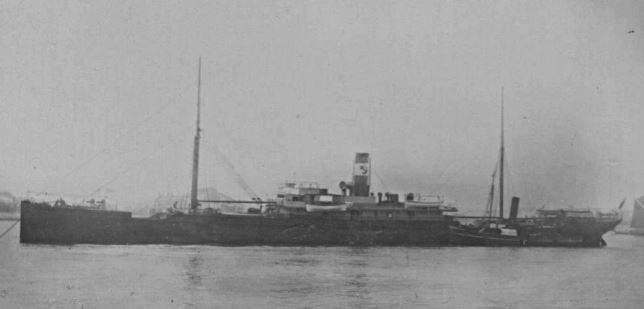
BERNARD WELBY SOMERFORD
Sergeant (Navigator (Bomber)), 420 (R.C.A.F.) Squadron, Royal Air Force (Service Number 658354)
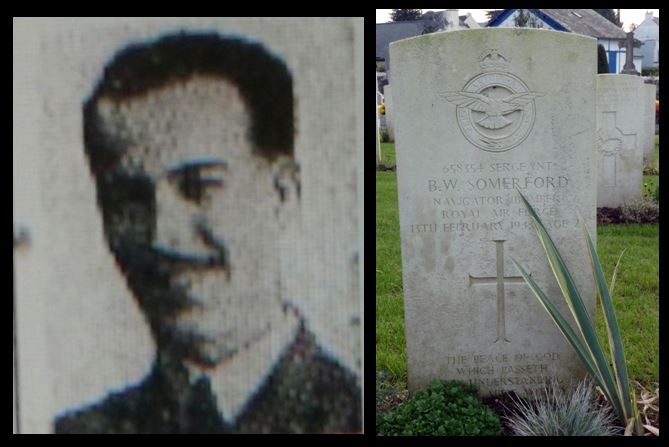
Bernard Welby Somerford was born in Tenbury, Worcestershire in 1920 to George William Welby Somerford, a drapers clerk, originally from Tunbridge Wells, Kent and Lavinia Annie Somerford, nee Hillier, a drapers assistant, originally from Frome, Somerset. The Somerford family moved to Cardiff living at 52 Princes Street and Bernard’s father worked as an advertising representative for the Western Mail and Echo but Bernard’s mother died when he was just twelve. He attended Cardiff High School for Boys and on leaving school he worked for Cardiff City council on the staff of the Public Assistance Department at Cardiff City Hall. He played cricket for Cardiff High Old Boys and was a member of Charles Street Congregational Church where he worked with the Youth Group. He joined the 6th Battalion Welsh Regiment (Territorials) in 1938 and remained in the Royal Artillery (Searchlights) until his transfer to the RAF in 1941. He died on 13 Feb 1943 aged 22 when the Wellington bomber he was in crashed near Lorient, Brittany. The plane had taken off from Middleton St. George airfield, Co Durham as part of a bombing raid on the port of Lorient. All five crew members were killed when the Wellington crashed in the target area. He is buried at Guidel Communal Cemetery in Brittany (Row 6, Grave 21). He is remembered on the memorial for Cardiff Corporation employees at Cardiff City Hall. Commonwealth War Graves record.
HERBERT SPENCE
Private, 11th Battalion, Welsh Regiment (Service Number 15514)
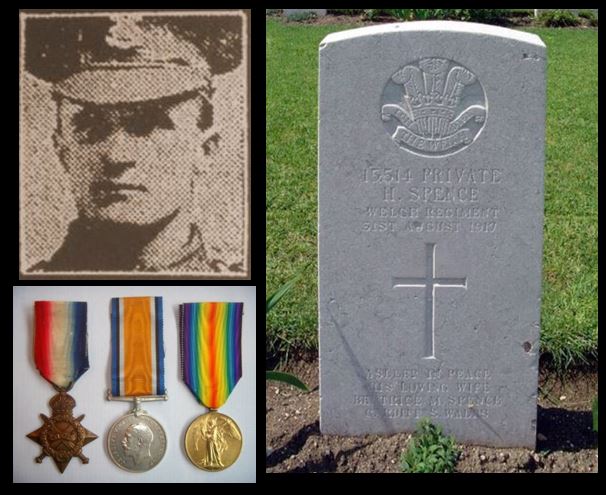
Herbert Spence was born in Middlesbrough in early 1881 to Marcus John Spence, a marine engineer originally from North Shields, and Faith Spence née Milburn, originally from Leeds. By 1891 the family had moved down to Newport and Herbert was in school but his mother Faith passed away in 1893. In 1901 the Spence family had moved to Cardiff living in Forrest Road, Canton. Herbert married Beatrice Mary Davies at St Mark’s Church, Gabalfa on 9 Aug 1915 when he was already serving in the Welsh Regiment. He was a well known in Canton football circles and he worked as a painter and decorator. He served with the 11th Battalion, Welsh Regiment and died of malaria on the 31 August 1917 in Salonika, Greece aged 37. He is buried in Mikra British Cemetery in Greece. The newspaper report of his death mentions his father living in Planet Street, Roath and his wife living at 71 Manor Street. Commonwealth War Graves Commission record.
PHINEAS GEORGE STACEY
Corporal, 4th Battalion, Welsh Regiment (Service Number: 3964576)
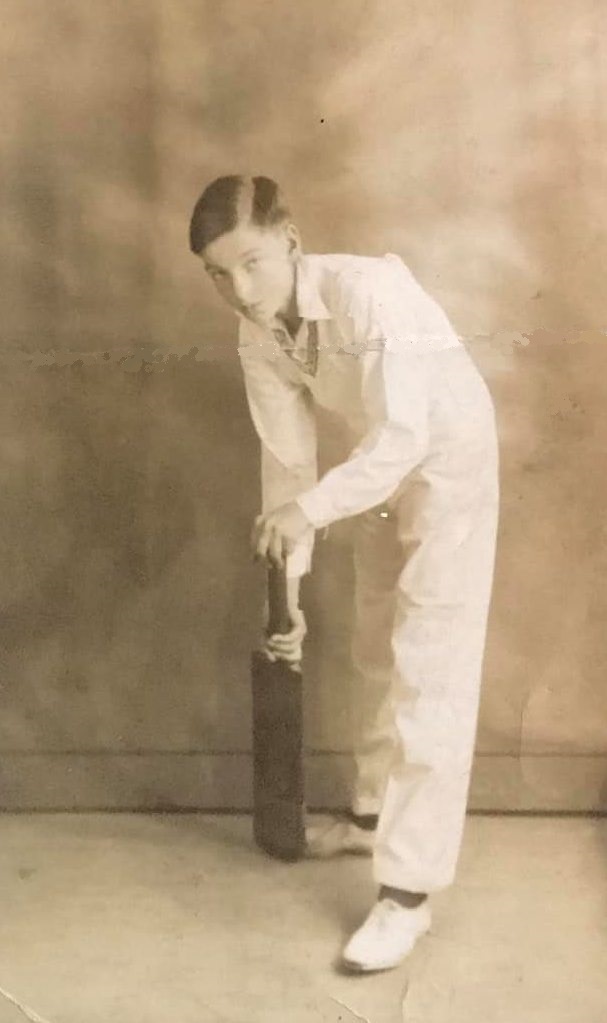
Phineas ‘Boyo’ George Stacey was born in Cardiff on 7 Apr 1919 the youngest of eleven children born to Frederick Stacey, a fuel worker, originally from South Petherton, Somerset, and Rowena Stacey née Shepperd, originally from Cardiff. He was baptised on 27 Apr 1919 at St German church when the family were living at 27 Helen Street. In 1939 Phineas was working as a car park attendant. He served as a Corporal with the 4th Battalion Welch Regiment. He died on 14 July 1944 age 25. He is buried at buried Banneville-La-Campagne War Cemetery near Caen, Normandy, France (grave X.B.23.). The inscription on his headstone reads ‘All who knew him loved him, his memory is in many hearts always’. Commonwealth War Graves Commission record.
BETTY MARY STANNARD
Leading Aircraftwoman, 953 Balloon Squadron, Women’s Auxiliary Air Force (Service Number 2068971)

Betty Mary Stannard was born in Kent in 1922 to Albert James Stannard, an Estate worker from Monkton, Kent, and Mary Eleanor Stannard née Williams. (Her father Albert worked on the estate belonging to Collingwood ‘Cherry’ Ingram, ornithologist and plant collector and son of Sir William Ingram, owner of London Illustrated News). Betty was a Leading Aircraftwoman with 953 Balloon Squadron, Women’s Auxiliary Air Force which was based at Cardiff Castle in WWII. She died on 18th May 1943, aged 21 when the barrage balloon site at which she was stationed at Colchester Avenue, Penylan took a direct hit during a bombing raid on Cardiff. Three WAAF balloon operators were killed and a further four injured. She is buried at St George’s in Benenden, Kent (grave reference : Row 13. Grave 59). Betty Mary Stannard is commemorated on the Benenden War Memorial in Kent. Commonwealth War Graves Commission record.
JOSEPH CATTELL STEPHENS
Lance Corporal, 11th Battalion, Welsh Regiment (Service Number: 15517)
Joseph Cattell Stephens was born in Cardiff in 1895 to Joseph Benjamin Stephens, a solicitor originally from Cardiff and Mary Jane Stephens née Thomas, originally from Gloucestershire. Joseph was baptised at St Margaret’s church on 26 Apr 1895 when the family were living at 27 Glenroy Street. Mary dies a couple of years after Joseph was born in 1897. In 1900 Joseph Benjamin Stephens remarries to Margaret Davies and in 1901 the family are living at 25 Marlborough Road. A year later, Joseph Cattell Stephens enrols at the newly opened Marlborough Road Primary School for boys. In 1911 the family are still at 25 Marlborough Road but Joseph Benjamin Stephens has again been widowed. Joseph Cattell Stephens, by this time 16, is described as a student. Joseph Cattell Stephens became a Corporal in the 11th Battalion, Welsh Regiment. He first served in France in Sep 1915. He was killed in 18 Sep 1918 aged 22 in the Salonika Campaign in Greece. His name appears on the Doiran Memorial which is in northern Greece, close to the Macedonian border. Joseph would have been part of the multi-national British Salonika Force (BSF) which included soldiers from Canada, New Zealand and Australia. After years of stalemate in the area, French and Serbian divisions attacked Bulgarian positions in mountains east of Monastir. Within three days they broke through the defences and continued to advance northward. In support of this operation the BSF again attacked the strong Bulgarian defences at Doiran on 18 Sept. The BSF suffered more than 7000 casualties which would have included Joseph Stephens. Commonwealth War Graves Commission record. He is remembered on the St Andrew’s URC War Memorial plaque. There may not be any surviving offspring from the Stephens family as Joseph’s brother, John Montague Stephens joined the merchant navy and sustained a fractured skull and died on board the vessel Trafalgar in Argentina in 1927. Joseph’s half-brother Reginald Gwynn Stephens joined the air force and died in Singapore in 1942.
REGINALD GWYNNE STEPHENS
Aircraftman 1st Class, 243 Squadron, Royal Air Force Volunteer Reserve (Service Number: 1067937)
Reginald Gwynne Stephens was born on 14 Jan 1906 in Cardiff to Joseph Benjamin Stephens, a solicitor, originally from Cardiff, and Margaret Stephens nee Davies, originally from Cardiff. The Stephens family lived at 25 Marlborough Road. Reginald’s mother died a couple of years after he was born. In 1939 Reginald was living with his aunt at 148 Lake Road East and working as a salesman. Later that year he married Sylvia Agnes Brown in Penarth. He served with the Royal Air Force Volunteer Reserve and died on 14 Feb 1942 aged 36. He is presumed to have been killed during the evacuation of Singapore and Sumatra. He is remembered on the Singapore Memorial at Kranji War Cemetery in Singapore (Column 418). Commonwealth War Grave Commission record. Reginald’s half-brother Joseph Cattell Stephens died during WWI.
THOMAS HENRY CUTHBERT STEPHENS
Signaller, 96th Siege Battery, Royal Garrison Artillery (Service Number 348208)
Thomas Henry Cuthbert Stephens was born on 6 May 1895 in Cardiff to Henry Stephens, a hydraulic crane operator and coal trimmer, and Hannah Maud Stephens nee Cooper both originally from Cardiff. He was baptised on 2 Aug 1895 that year at St Margaret’s church, Roath. In 1901 the family lived Talworth Street. He attended Marlborough Road School and later Albany Road School where he won the 100yds hurdle at the Cardiff Schools Sports Day in 1908 before moving on to Howard Gardens school later that year. In 1911 the Stephens family lived in 83 Keppoch Street and Cuthbert was working as a junior clerk. The Stephens family then moved again to lived at 26 Roath Court Road. He enlisted 3 September 1914. He survived the war and was discharged 8 Mar 1919 having been previously injured or due to illness but died on 18 Mar 1920 in Cardiff aged 24. He is buried at Cathays Cemetery, Cardiff (grave VL. CE. 32.). He is included on the memorial at St Edward’s Church, Roath. The Processional Cross used at St Edward’s church was dedicated in his memory. Commonwealth War Graves Commission record.
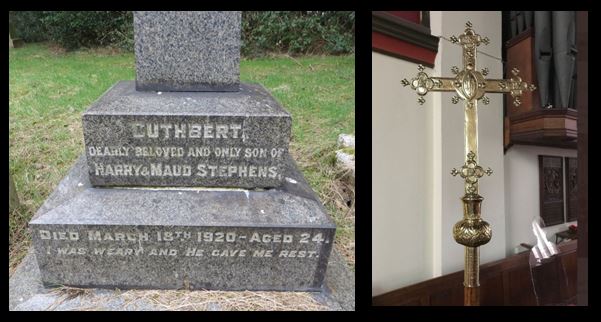
WILLIAM HARRY STRACHAN
Private, 1st Battalion, Royal Welsh Fusiliers (Service Number 56643)
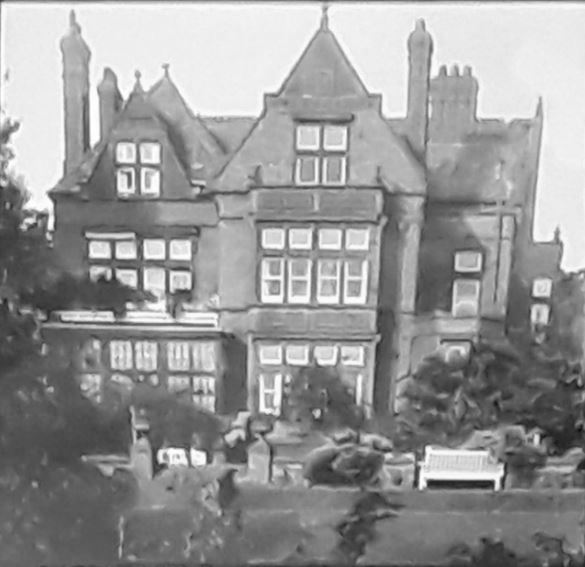
William Harry Strachan was born in Cardiff in 1886 to John Stachan, originally from Aberdeen, Scotland and Catherine Cecilia Strachan née Lewis from Cardiff. He was baptised in Llanishen on October 21st that year where his mother Catherine had been born. His father John Strachan was a very successful civil engineer working on railway projects and the building of Roath dock. The family lived in Craigisla, a large mansion house on Ty-Gwyn Road in Pen-y-lan, Cardiff. William Stachan was one of at least ten children that Catherine and John Strachan had. Some of the children became engineers like their father. In 1901 William, aged 14, is living with his parents in Craigisla, Pen-y-lan. He attended Cardiff High School for Boys. He doesn’t appear on the 1911 census and is probably working aboard because in January 1916 he arrives in Liverpool aboard the ship Orita having boarded in Rio de Janeiro. He is named as a secretary working for the Brazilian Traction Light & Power Company. Presumably he returned home in order to sign up for the army. William Strachan was a Private in the Royal Welsh Fusiliers. He died on 27th August 1916 aged 30. He was killed in the Battle of the Somme in France and his name appears on the Thiepval Memorial which is a memorial to those who died in that battle but with no known grave. He is also remembered on the War Memorial plaque in St Andrew’s URC church, Wellfield Rd, Roath, Cardiff (note middle name misspelt as Henry on plaque). He is also remembered on the Cardiff High School memorial. Commonwealth War Graves Commission record.
PHILIP ERNEST STRATTON
Private, 2nd Battalion, Duke of Cornwall’s Light Infantry (Service Number: 27954)
Philip Ernest Stratton was born in Cardiff in 1884 to Henry James Stratton, an ironware dealer, originally from Southampton, and Mary Jane Stratton née Thomas, originally from St Austell, Cornwall. In 1891 the Stratton family lived in Arran Street, Roath. By 1901 they had moved to 149 MacKintosh Place. After leaving school Ernest worked as a law clerk. In 1912 he married Edith Emma White in Cardiff. They went on to have two sons together. Ernest Stratton served in the 2nd Battalion, Duke of Cornwall’s Light Infantry. He died on 25 Nov 1918 in Bulgaria of bronchial pneumonia and influenza aged 34. He is buried at the Sofia War Cemetery (plot I.C.5). He is remembered on the Trinity Church War Memorial plaque. Commonwealth War Graves Commission record.
HENRY GEORGE STRIDE
Lance Corporal, 2nd Battalion, Royal West Surrey Regiment (Service Number: G/81295)
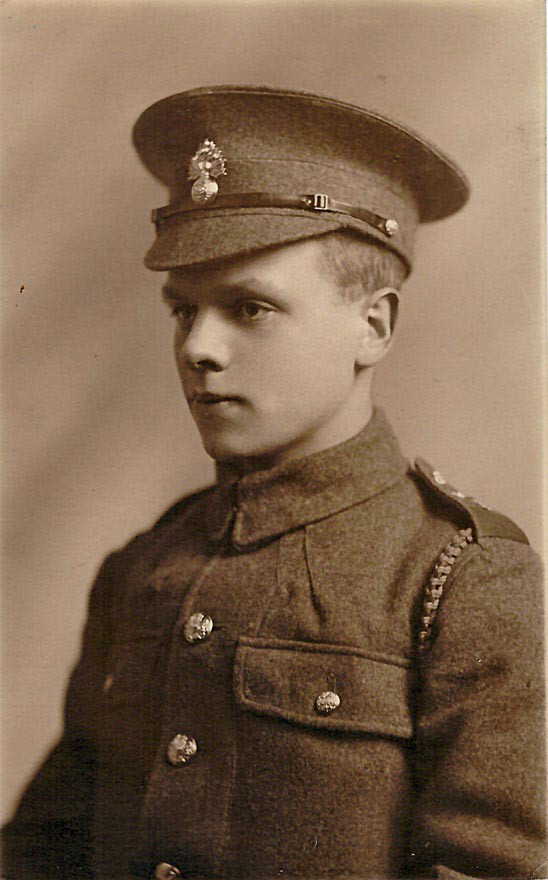
Henry George Stride was born in Newport on 14 Apr 1894 to Abraham Cornelius Stride, a railway clerk, originally from Bath, Somerset and Rosa Emma Stride née Sier, originally from Newport. By 1901 the family have moved to Cardiff and living at 16 Marlborough Road. In 1905 when Henry is admitted to Marlborough Road School the family address given was Penywaun Place, Roath. In 1911 the family are living at 23 Alma Road, Roath. Harry is now aged 16 and working as a Colliery Clerk. During the war Harry Stride was a Lance Corporal in the 2nd Battalion Royal West Surrey Regiment. He died in Italy on 29 Oct 1918, aged 25, just a couple of weeks before the end of the war. The Battle of Vittorio Veneto was fought from 24 Oct to 3 Nov 1918 near Vittorio Veneto on the Italian Front during World War I. The allies victory marked the end of the war on the Italian Front, secured the dissolution of the Austro-Hungarian Empire and contributed to the end of the First World War just one week later. Harry Stride is buried in the Tezze British Cemetery (Plot 4. Row A. Grave 12) in Veneto, Italy, not far north of Venice. Commonwealth War Graves Commission record. He is remembered on the St Andrew’s URC church memorial. (There is a possibility he is also the Harry G Stride on the Llanbradach War Memorial but I suspect this may well be an error and should be Herbert Gladstone Stride who was a coalminer from Llanbradach who also was killed in 1918).
VINCENT GERARD SULLIVAN
Sergeant, 77 Squadron, Royal Air Force Volunteer Reserve (Service Number 969335)
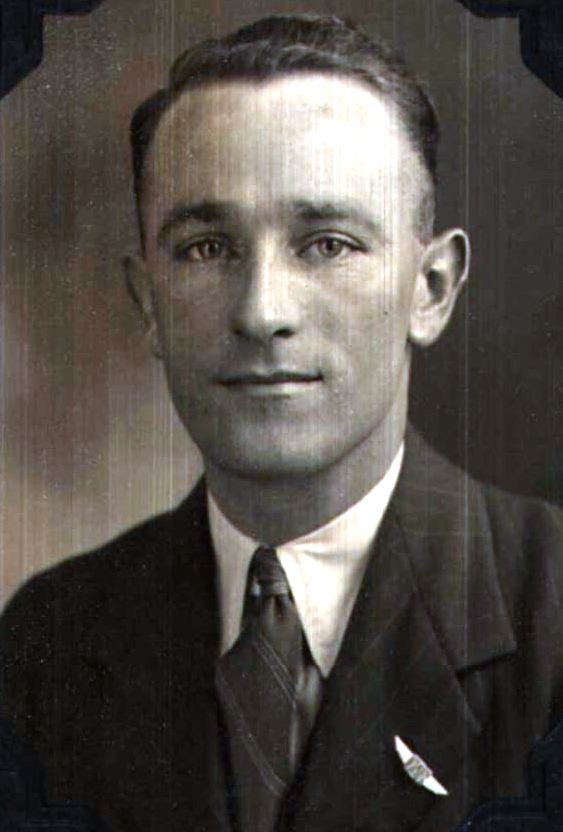
Vincent Gerard Sullivan was born on 13 Jan 1915 in Cardiff to William Sullivan, a bricklayer at the steel works, originally from Blaenavon, Monmouthshire, and Josephine Sullivan née Steel, originally from South Shields, Durham, and a teacher. Vincent attended St Illtyd’s school 1926-29. The family at 148 Habershon Street, Splott. In 1937 Vincent was best man at his sister Josephine’s wedding when she married Richard Tecwyn Williams at St Alban church (R T Williams went on to become a famous toxicologist). In 1939 Vincent was working as an bus conductor when he got his Royal Aero Club Aviators’ Certificate at Cardiff Aeroplane Club in a Gypsy Moth aircraft. In WWII he was a Sergeant with 77 Squadron of the Royal Air Force Volunteer Reserve. He lost his life in an air crash on 24 Nov 1940 aged 29. He was one of five crew aboard a Whitley V bomber which took off at 17.30 from Topcliffe airfield in Yorkshire on a mission in Italy. It is believed it ran out of fuel on its return and ditched in the Strait of Dover. Vincent’s body was not recovered. He is remembered on the Runnymede Memorial, Surrey and also the St Illtyd’s School war memorial plaque now at St Alban church, Splott. Commonwealth War Graves Commission record.



